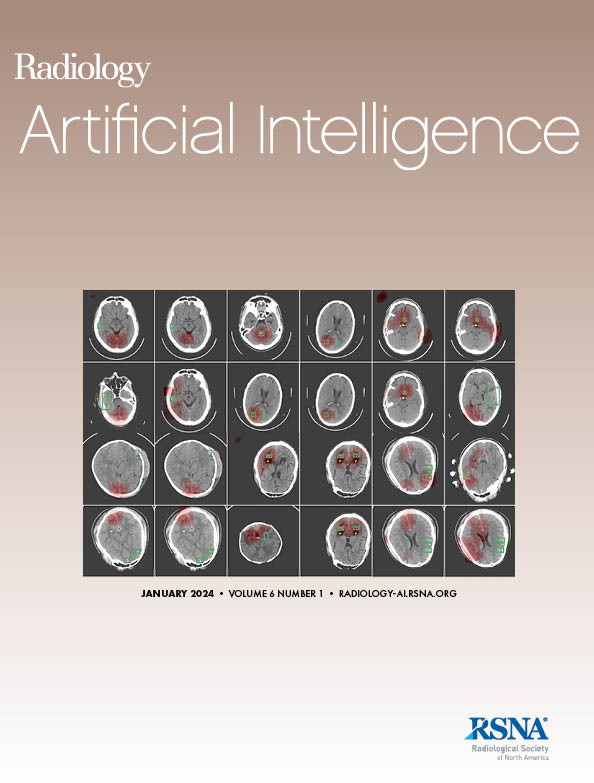Evaluating Performance of a Deep Learning Multilabel Segmentation Model to Quantify Acute and Chronic Brain Lesions at MRI after Stroke and Predict Prognosis.
IF 13.2
Q1 COMPUTER SCIENCE, ARTIFICIAL INTELLIGENCE
Tianyu Tang, Ying Cui, Chunqiang Lu, Huiming Li, Jiaying Zhou, Xiaoyu Zhang, Yujie Zhou, Ying Zhang, Yi Zhang, Yuhao Xu, Yuefeng Li, Shenghong Ju
求助PDF
{"title":"Evaluating Performance of a Deep Learning Multilabel Segmentation Model to Quantify Acute and Chronic Brain Lesions at MRI after Stroke and Predict Prognosis.","authors":"Tianyu Tang, Ying Cui, Chunqiang Lu, Huiming Li, Jiaying Zhou, Xiaoyu Zhang, Yujie Zhou, Ying Zhang, Yi Zhang, Yuhao Xu, Yuefeng Li, Shenghong Ju","doi":"10.1148/ryai.240072","DOIUrl":null,"url":null,"abstract":"<p><p>Purpose To develop and evaluate a multilabel deep learning network to identify and quantify acute and chronic brain lesions at multisequence MRI after acute ischemic stroke (AIS) and assess relationships between clinical and model-extracted radiologic features of the lesions and patient prognosis. Materials and Methods This retrospective study included patients with AIS from multiple centers, who experienced stroke onset between September 2008 and October 2022 and underwent MRI as well as thrombolytic therapy and/or treatment with antiplatelets or anticoagulants. A SegResNet-based deep learning model was developed to segment core infarcts and white matter hyperintensity (WMH) burdens on diffusion-weighted and fluid-attenuated inversion recovery images. The model was trained, validated, and tested with manual labels (260, 60, and 40 patients in each dataset, respectively). Radiologic features extracted from the model, including regional infarct size and periventricular and deep WMH volumes and cluster numbers, combined with clinical variables, were used to predict favorable versus unfavorable patient outcomes at 7 days (modified Rankin Scale [mRS] score). Mediation analyses explored associations between radiologic features and AIS outcomes within different treatment groups. Results A total of 1008 patients (mean age, 67.0 years ± 11.8 [SD]; 686 male, 322 female) were included. The training and validation dataset comprised 702 patients with AIS, and the two external testing datasets included 206 and 100 patients, respectively. The prognostic model combining clinical and radiologic features achieved areas under the receiver operating characteristic curve of 0.81 (95% CI: 0.74, 0.88) and 0.77 (95% CI: 0.68, 0.86) for predicting 7-day outcomes in the two external testing datasets, respectively. Mediation analyses revealed that deep WMH in patients treated with thrombolysis had a significant direct effect (17.7%, <i>P</i> = .01) and indirect effect (10.7%, <i>P</i> = .01) on unfavorable outcomes, as indicated by higher mRS scores, which was not observed in patients treated with antiplatelets and/or anticoagulants. Conclusion The proposed deep learning model quantitatively analyzed radiologic features of acute and chronic brain lesions, and the extracted radiologic features combined with clinical variables predicted short-term AIS outcomes. WMH burden, particularly deep WMH, emerged as a risk factor for poor outcomes in patients treated with thrombolysis. <b>Keywords:</b> MR-Diffusion Weighted Imaging, Thrombolysis, Head/Neck, Brain/Brain Stem, Stroke, Outcomes Analysis, Segmentation, Prognosis, Supervised Learning, Convolutional Neural Network (CNN), Support Vector Machines <i>Supplemental material is available for this article.</i> © RSNA, 2025.</p>","PeriodicalId":29787,"journal":{"name":"Radiology-Artificial Intelligence","volume":" ","pages":"e240072"},"PeriodicalIF":13.2000,"publicationDate":"2025-05-01","publicationTypes":"Journal Article","fieldsOfStudy":null,"isOpenAccess":false,"openAccessPdf":"","citationCount":"0","resultStr":null,"platform":"Semanticscholar","paperid":null,"PeriodicalName":"Radiology-Artificial Intelligence","FirstCategoryId":"1085","ListUrlMain":"https://doi.org/10.1148/ryai.240072","RegionNum":0,"RegionCategory":null,"ArticlePicture":[],"TitleCN":null,"AbstractTextCN":null,"PMCID":null,"EPubDate":"","PubModel":"","JCR":"Q1","JCRName":"COMPUTER SCIENCE, ARTIFICIAL INTELLIGENCE","Score":null,"Total":0}
引用次数: 0
引用
批量引用
Abstract
Purpose To develop and evaluate a multilabel deep learning network to identify and quantify acute and chronic brain lesions at multisequence MRI after acute ischemic stroke (AIS) and assess relationships between clinical and model-extracted radiologic features of the lesions and patient prognosis. Materials and Methods This retrospective study included patients with AIS from multiple centers, who experienced stroke onset between September 2008 and October 2022 and underwent MRI as well as thrombolytic therapy and/or treatment with antiplatelets or anticoagulants. A SegResNet-based deep learning model was developed to segment core infarcts and white matter hyperintensity (WMH) burdens on diffusion-weighted and fluid-attenuated inversion recovery images. The model was trained, validated, and tested with manual labels (260, 60, and 40 patients in each dataset, respectively). Radiologic features extracted from the model, including regional infarct size and periventricular and deep WMH volumes and cluster numbers, combined with clinical variables, were used to predict favorable versus unfavorable patient outcomes at 7 days (modified Rankin Scale [mRS] score). Mediation analyses explored associations between radiologic features and AIS outcomes within different treatment groups. Results A total of 1008 patients (mean age, 67.0 years ± 11.8 [SD]; 686 male, 322 female) were included. The training and validation dataset comprised 702 patients with AIS, and the two external testing datasets included 206 and 100 patients, respectively. The prognostic model combining clinical and radiologic features achieved areas under the receiver operating characteristic curve of 0.81 (95% CI: 0.74, 0.88) and 0.77 (95% CI: 0.68, 0.86) for predicting 7-day outcomes in the two external testing datasets, respectively. Mediation analyses revealed that deep WMH in patients treated with thrombolysis had a significant direct effect (17.7%, P = .01) and indirect effect (10.7%, P = .01) on unfavorable outcomes, as indicated by higher mRS scores, which was not observed in patients treated with antiplatelets and/or anticoagulants. Conclusion The proposed deep learning model quantitatively analyzed radiologic features of acute and chronic brain lesions, and the extracted radiologic features combined with clinical variables predicted short-term AIS outcomes. WMH burden, particularly deep WMH, emerged as a risk factor for poor outcomes in patients treated with thrombolysis. Keywords: MR-Diffusion Weighted Imaging, Thrombolysis, Head/Neck, Brain/Brain Stem, Stroke, Outcomes Analysis, Segmentation, Prognosis, Supervised Learning, Convolutional Neural Network (CNN), Support Vector Machines Supplemental material is available for this article. © RSNA, 2025.
评估深度学习多标签分割模型在脑卒中后MRI上量化急慢性脑损伤和预测预后的性能。
“刚刚接受”的论文经过了全面的同行评审,并已被接受发表在《放射学:人工智能》杂志上。这篇文章将经过编辑,布局和校样审查,然后在其最终版本出版。请注意,在最终编辑文章的制作过程中,可能会发现可能影响内容的错误。目的开发和评估一个多标签深度学习网络,用于在急性缺血性卒中(AIS)后的多序列MRI上识别和量化急性和慢性脑病变,并评估病变的临床和模型提取的放射学特征与患者预后之间的关系。材料和方法本回顾性研究纳入了来自多个中心的AIS患者(2008年9月至2022年10月),这些患者接受了MRI和溶栓或抗血小板和/或抗凝治疗。开发了基于segresnet的深度学习模型,用于在弥散加权成像和流体衰减反演恢复图像上分割核心梗死和白质高强度(WMH)负担。该模型使用手动标签进行训练、验证和测试(每个数据集中分别有n = 260、60和40名患者)。从模型中提取的放射学特征,包括局部梗死面积、心室周围和深部WMH体积和簇数,结合临床变量,用于预测患者7天的有利和不利结果(改良Rankin量表[mRS]评分)。中介分析探讨了不同治疗组放射学特征与AIS结果之间的关系。结果共1008例患者(平均年龄67.0±11.8岁;男性686例,女性322例)。训练和验证数据集包括702例AIS患者,两个外部测试数据集分别包括206例和100例患者。结合临床和放射学特征的预后模型在两个外部测试数据集中预测7天预后的auc分别为0.81 (95% CI: 0.74-0.88)和0.77 (95% CI: 0.68-0.86)。中介分析显示,接受溶栓治疗的患者的深度WMH对不良结局有显著的直接影响(17.7%,P = 0.01)和间接影响(10.7%,P = 0.01),这表明mRS评分较高,而在接受抗血小板和/或抗凝药物治疗的患者中没有观察到这一点。结论提出的深度学习模型定量分析急慢性脑病变的影像学特征,并结合临床变量提取影像学特征预测AIS的短期预后。WMH负担,特别是深度WMH,已成为溶栓治疗患者预后不良的一个危险因素。©RSNA, 2025年。
本文章由计算机程序翻译,如有差异,请以英文原文为准。

 求助内容:
求助内容: 应助结果提醒方式:
应助结果提醒方式:


